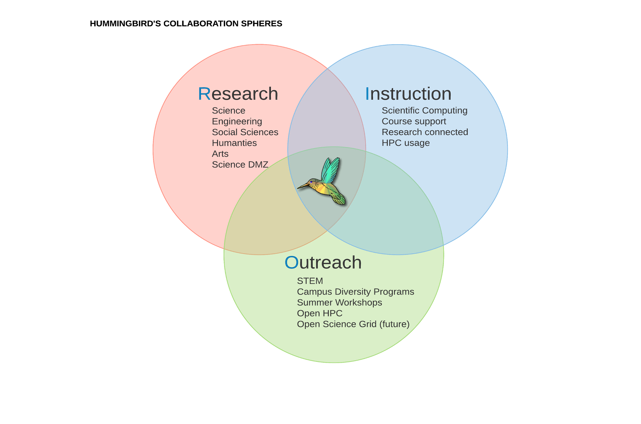By Stephen Hauskins. High-end computational capabilities and support are rapidly becoming a necessity for UC Santa Cruz faculty, students, researchers, and collaborators. However, access to this type of capability is disproportionately distributed. Hummingbird, a shared computational cluster, is UCSC’s response to this inequality, providing a computational resource to the many individuals or groups that don’t have local access to anything else.
The concept behind Hummingbird is that Information Technology Services (ITS) staff embedded in all of the academic divisions provide support for the shareable resources. This translates to overall lower cost; gives more researchers, students, and instructors access to computing resources; and helps the campus manage the support load associated with growing demand.
Because the Hummingbird service team is distributed across the academic divisions, it successfully represents the particular needs of the different constituencies: science, engineering, social sciences, humanities, and arts. The shared team structure also recognizes the many overlapping components of doing high-level computing, enabling the team to leverage resources and address the majority of need.
Alignment to the campus vision
Hummingbird converges needs with existing resources. UC Santa Cruz already has well-established Science DMZ, ceph file storage system, data center, and network services. Hummingbird offers a way for faculty, researchers, graduate students, and undergraduate students in multiple divisions and departments access to research and instructional computing resources so as to leverage these other services.
From genomics to particle physics, UC Santa Cruz is on the frontline of supporting emerging cross-discipline collaborations across the campuses and across the country, and even to some degree across the world (CERN). Hummingbird enables the campus to support and promote STEM projects and give the student population resources that would otherwise not be available to them.
Training the users
The team supports a broad spectrum of clients – from linguistics to economics, from genomics to computational media. It supplies clear documentation via the website on how to use the service, and offers a “best effort” platform for training and education on the usage of the Hummingbird cluster, from basic terminal command line interaction, software installation assistance, to submitting computational jobs. We also participate directly in courses for cluster usage instruction. Having discovered that many students, including graduate students, arrive on campus without the necessary basic skills, we are developing open workshops for each academic quarter to cover basic cluster usage.
From solution to innovation
Hummingbird is also a bridge between local clusters and those located at various institutions: San Diego Supercomputer Center, TACC, NERSC, and national research laboratories. We have modeled the architecture after larger open-access computational clusters, such as Comet and Stampede, to enable interoperability and provide a local environment where researchers can develop proof of concepts to support their application to these larger environments.
It can also provide a path to using cloud-based services like Amazon and Google. The team is pursuing the best avenues to utilize cloud computing to augment our computing environment. The future is certainly a hybrid model of local resources, large-scale HPC facilities, and cloud service providers.
Hummingbird seeks to be nimble and responsive to client needs. We can rapidly install and upgrade compute nodes, install or update software, analyze client needs and create a solution. For example, when the cluster as configured cannot support a particular need, we can create containers that allow the users to use the cluster via a specialized compute environment available through the Lawrence Berkeley National Laboratory. This solution came about when a linguistics faculty member needed a particular computing environment for their software. We also recently introduced GPU computing to the environment so that we could meet growing course and individual requests for machine learning and digital media projects.
 Stephen Hauskins is the computing director for the Division of Physical and Biological Sciences at UC Santa Cruz and manages the Hummingbird Cluster for the Academic Divisional Computing group in Information Technology Services.
Stephen Hauskins is the computing director for the Division of Physical and Biological Sciences at UC Santa Cruz and manages the Hummingbird Cluster for the Academic Divisional Computing group in Information Technology Services.







